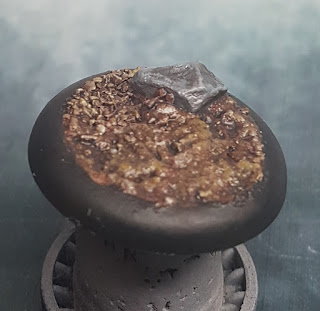Also in use for this base - some sand and gravel along with a base with tape over it and a glue spreader.
When you open the pot, you find that there is some stuck to the lid - this has dried out already, and is useful for creating some height on the base prior to the addition of an even layer of paste on the base, up to just over the lip of the rim. You can also use putty, such as milliput to create raised areas before applying the paste.
At this point while the paste is wet, you can add extra stuff, such as sand and pebbles to add a little more interest.
This then takes a few hours to dry, but when it is dry, the paste dries unevenly.
 |
| Another example - this was an even layer that has dried in an inconsistent fashion. |
Now for paint! There isn't a set scheme for this, I just grabbed a handful of different browns, with some Vallejo Deck Tan and Scale Color Peanut Butter to mix in as highlights.
After an initial basing layer, I grabbed a piece of blister sponge, cut to an uneven angle. This means that you have loads of different angles to use to dab onto the base with, so you don't get consistent patterns.
After a few shades have been dabbed or drybrushed on, I drowned it in Devlan Mud to blend it together.
This was followed by even more layers dabbed on, with different highlights put in different places.
The final look is that of a simple dirt base - you can add some static grass, as I have done on the larger base below, but the Boglin this regular 30mm base is for is quite small so I didn't want to crowd him with anything more than he already had.
So there we go! It's not going to win any medals on its own, but it's a base that even if every one you do is done the same way, it's almost impossible for them to be identical, which makes them great for basing an army.
Next week I'll be showing off the Boglin that's going to be going on the base.

















